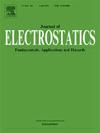Finite element analysis of a 3D triboelectric nanogenerator for biophysical health monitoring applications
Abstract
The Triboelectric nanogenerator (TENG) has numerous applications in biophysical health monitoring due to its small size, lightweight, and economical use. The triboelectric effect occurs when two triboelectric materials with opposite polarities come into contact or rub against each other. This paper presents the simulated output performance of a three-dimensional TENG with two opposite dielectric circular layers separated by a distance of 0.05 μm. The bottom negative layer of polytetrafluoroethylene (PTFE) with a 0.5 μm diameter and 0.1 μm thickness has a negative aluminium electrode with the same dimensions. The top of the negative layer has cylindrical surface morphology. A layer of copper serves as both a positive layer and electrode with a diameter of 1 μm and a thickness of 0.1 μm. Furthermore, for analysis, PTFE is replaced by polyvinyl chloride (PVC) and polyethylene and the results are compared. The Finite Element Analysis (FEA) was used to analyze the geometry, employing a combination of Solid mechanics and Electrostatic module of COMSOL Multiphysics 5.6 software. The result shows that a maximum output voltage of 35.9 V was observed for an applied pulse pressure of 3 kPa as input. The results indicate that the TENGs have the potential to be used for various devices and wearable healthcare monitors.

 求助内容:
求助内容: 应助结果提醒方式:
应助结果提醒方式:


